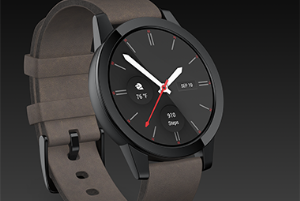Qualcomm Technologies, Inc., a subsidiary of Qualcomm Inc., has launched its next generation Qualcomm Snapdragon Wear 3100 platform for smartwatches.
The platform is based on a new ultra-low power system architecture designed to deliver a rich interactive mode, new personalised experiences, and extended battery life. The official launch, at an event in San Francisco, was supported by Google, who discussed the evolution of the Wear OS by Google software platform. The launch also included the announcement of the first Snapdragon Wear 3100 customers.
Snapdragon Wear 3100 is based on a new ultra-low power hierarchical system architecture approach. In this architecture, the high-performance quad core A7 processors, the highly efficient integrated DSP, and a new ultra-low power co-processor work in conjunction with each other to help customers re-imagine new smartwatch experiences while supporting extended battery life.
The new capabilities are designed to allow consumers to enjoy the beauty of a fashion watch with the power of a smartwatch, the battery life of a sports watch with the richness of a smartwatch, and the utility of an analog watch with the flexibility of a smartwatch.
“Qualcomm Technologies has played a critical role in the evolution of the smartwatch segment and our customers are currently shipping more than 100 Wear OS by Google smartwatches with 25 brands globally based on our existing platforms,” said Anthony Murray, senior vice president and general manager, voice & music, Qualcomm Technologies International, Ltd.
“With the Snapdragon Wear 3100 Platform, we envisioned a new ultra-low power system architecture and in collaboration with the latest from the Wear OS by Google team, to help deliver a rich interactive mode, bring in new personalised experiences and support extended battery life for tomorrow’s smartwatches. We are delighted to announce Fossil Group, Louis Vuitton, and Montblanc as our first Snapdragon Wear 3100 customers.”

The new co-processor, the Qualcomm QCC1110, has been designed from the ground up and is at the heart of the Snapdragon Wear 3100 platform. It is incredibly small at ~21mm2, is optimised for ultra-low power operation, and acts as a powerful companion to the main processor, re-defining audio, display, and sensor experiences for next generation smartwatches. The co-processor also integrates a deep learning engine for custom workloads, such as keyword detection, and is extensible over time.
Additionally, the Snapdragon Wear 3100 platform includes a new wearable power management sub-system (PMW3100) to support lower power and higher integration, brings in a new DSP framework to support next generation sensor processing in an open execution environment, and implements a new dual display architecture to support the hierarchical approach.
The 4G LTE modem, proven in mobile applications, and which has already shipped over one billion units, is paired with new high-performance Gallium Arsenide power amplifiers, which helps to increase power efficiency in smartwatches.
The Snapdragon Wear 3100 platform, in conjunction with the latest from Wear OS by Google,is designed to deliver a rich interactive mode, new personalised experiences, and support for extended battery life.
Rich interactive mode
Snapdragon Wear 3100 platform serves as a strong, proven foundation for rich interactions by helping to deliver high performance, superior connectivity, smart sensing, and compelling features. Qualcomm Technologies is collaborating closely with the Wear OS by Google team to utilise and enhance the capabilities of the Snapdragon Wear 3100 platform and support increasingly rich, fluid experiences designed for the wrist.
“Together with Qualcomm Technologies and the ecosystem, Wear OS by Google has enabled a vibrant set of wearable devices, offering consumers with great choice and diversity,” said Dennis Troper, director of product management, Wear OS by Google.
“We’re excited to see Qualcomm Technologies’ new Snapdragon Wear 3100, their continued investment in the wearable space, and we look forward to the ecosystem bringing the next generation of smartwatch technology to the industry.”
New personalised experiences
Snapdragon Wear 3100 platform, based on the new ultra-low power system architecture, is being used to help bring new personalised experiences to next generation Wear OS by Google based smartwatches. Three such personalised experiences include the Enhanced Ambient Mode, Dedicated Sports Experiences, and Traditional Watch Mode.
The Enhanced Ambient Mode helps the smartwatch to meet consumer desires for a fashion watch by supporting a smooth second hand, up to 16 colors, live complications and improved brightness. The Dedicated Sports Experiences is designed to allow active users to go for an ultra-marathon, swim long distances, bike for miles, or hike the mountains with GPS and heart rate turned on for the duration.
The Traditional Watch Mode is designed to make it possible for consumers to continue to enjoy their beautiful watch for extended periods of time. Each one of these personalised experiences are supported by offloading the display and sensor processing from the A7 processors to the ultra-low power co-processor.

Support for extended battery life
Snapdragon Wear 3100 Platform is designed to help reduce power usage and bring increased flexibility for consumers to experience the benefits of extended battery life. The new platform is designed to help reduce power usage in areas such as low power modes, GPS/location batching, per minute/second clock updates, sensors processing, MP3 playback, and Wi-Fi/Bluetooth voice queries.
This results in typical battery life day of use improvements ranging from 4 to 12 hours compared to the previous Snapdragon Wear 2100 platform, depending on display type, battery capacity, and device configurations. The new personalised sports experiences keep GPS and heart rate monitoring on for the duration of the activities and is designed to deliver up to 15 hours battery life (calculated based on typical 450mAh sports watch battery).
The Traditional Watch Mode, great for travelling, supports an impressive week-long battery life to the smartwatch by switching to this mode from the Wear OS by Google experience and is designed to allow consumers to enjoy basic watch functions for an extended period.
Fossil Group, Louis Vuitton, and Montblanc were announced as the first customers to launch products based on the Snapdragon Wear 3100 platform. These companies are working to bring beautiful smartwatches for a diverse set of consumers including lifestyle sports users, fashionable travelers, and those seeking a high-end luxury smart timepiece.
“Louis Vuitton has long been known for combining tradition and modernity in the luxury world,” said Eric Pradon, senior vice president of finance and administration at Louis Vuitton Malletier. “With the Louis Vuitton Tambour Horizon smartwatch, we collaborated with Google and Qualcomm Technologies to combine our exquisite design and watchmaking know-how with the best of technology, in order to delight our customers.”
“We are excited about the new possibilities that Snapdragon Wear 3100 brings to our customers and are working with Qualcomm Technologies to bring another beautiful smartwatch to the industry.”
Comment on this article below or via Twitter: @IoTNow_OR @jcIoTnow










